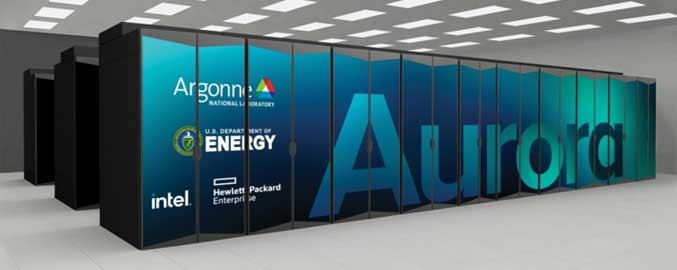(Supercomputer Series part 2 of 4)

In 2009 Computerworld projected exascale computers would debut by 2018. But now, as 2021 has come and gone, will exascale computers be finally realized this year? Or are exascale computers already running in secret?
Exascale computing is the current Holy Grail in computer performance partly because exascale computing power is roughly equivalent to the computing power of the human brain. Many countries are developing exascale performing supercomputers which will be able to perform 1 quintillion (1018 or 1,000,000,000,000,000,000) double precision floating point calculations per second. The United States, The European Union and China all have exascale computers under development. (Of course, a traditional supercomputer cannot perform the same tasks of the human brain and vice versa. Exascale computing performance is only an estimate of compute power.)
The world’s first exascale computer may be HPE’s Aurora. Aurora is a $600 million collaboration between Intel and Cray Inc. (now HPE). Installation of Aurora at the U. S. Department of Energy’s Argonne National Laboratory in Chicago began in October 2021. Aurora’s HPE Cray XE supercomputer platform is expected to have over 9000 nodes. Each node comprises two Intel Xeon Sapphire Rapids CPUs and six Ponte Vecchio GPUs. Aurora is now targeting greater than 2 exaflops of performance.
Also in the running is Frontier, the exascale computer collaboration between AMD and HPE.
The U.S. Department of Energy announced a contract with Cray Inc. (now HPE) to build the Frontier supercomputer at Oak Ridge National Laboratory in May 2019. Frontier was anticipated to be operational in 2021 and boast a performance of 1.5 exaflops. It’s now scheduled to be operational in the first half of 2022. Powered by AMD’s optimized generation 3 Epyc CPUs and its Radeon Instinct GPUs, Frontier will consume 30 MW and have a footprint of 7,300 sq. ft. (2225 m2).
But has China already scooped the US by building not one, but 2 exascale computers? An anonymous source claims that The National Supercomputing Center in Wuxi, China is already running an operational exascale computer with sustained performance of 1.05 exaflops, a peak performance of 1.3 exaflops and consuming about 35 MW. Named “Oceanlite”, it is successor to the Sunway TaihuLight, which is officially recognized as China’s most powerful supercomputer. Simultaneously, China’s National University of Defense Technology may possess yet another exascale computer with performance similar to Oceanlite. Probably named Tianhe-3, it is powered by China’s Phytium Technology Co., Ltd’s FeiTeng processors which were developed internally after U.S. trade sanctions prevented China from acquiring Intel’s Xeon Phi processors.
Up to now, the performance of Oceanlite and Tiannhe-3 are state secrets and it’s unclear why China hasn’t publicized their existence.
BDA
Next: The Supercomputer Series
Part 3 of 4. The Human Brain vs. the Computer.
Part 4 of 4. The Quantum Computer
 en
en fr
fr